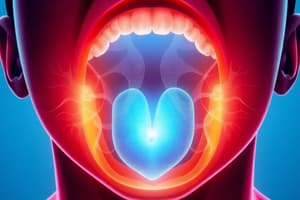Podcast
Questions and Answers
What is the primary digestive role of saliva?
What is the primary digestive role of saliva?
- Moistening dry food for easier consumption (correct)
- Hydrolyzing protein into amino acids
- Facilitating the absorption of nutrients
- Hydrolyzing starch into glucose
Which of the following substances does saliva contain that aids in starch digestion?
Which of the following substances does saliva contain that aids in starch digestion?
- Urea
- Ptyalin (correct)
- Pepsin
- Lipase
Which cells are primarily involved in the secretion of saliva within the salivary glands?
Which cells are primarily involved in the secretion of saliva within the salivary glands?
- Epithelial cells
- Ductal cells
- Acini cells (correct)
- Myoepithelial cells
What is one of the non-digestive roles of saliva?
What is one of the non-digestive roles of saliva?
Which factor is NOT associated with increased saliva flow?
Which factor is NOT associated with increased saliva flow?
How does saliva contribute to thermoregulation?
How does saliva contribute to thermoregulation?
What component primarily influences the isotonic nature of primary saliva?
What component primarily influences the isotonic nature of primary saliva?
What is the main function of the striated cells found in salivary ducts?
What is the main function of the striated cells found in salivary ducts?
Which organic substance is primarily involved in nitrogen metabolism in mammals and is also found in saliva?
Which organic substance is primarily involved in nitrogen metabolism in mammals and is also found in saliva?
Which gland primarily consists of serous acini?
Which gland primarily consists of serous acini?
What is the significance of the acinar arrangement of secretory cells in the salivary glands?
What is the significance of the acinar arrangement of secretory cells in the salivary glands?
Which component of saliva has antiseptic properties?
Which component of saliva has antiseptic properties?
What is the pH range of the final composition of saliva?
What is the pH range of the final composition of saliva?
Which of the following best describes the role of the Auerbach plexus?
Which of the following best describes the role of the Auerbach plexus?
What regulates the reabsorption of Na and secretion of K in the salivary ducts?
What regulates the reabsorption of Na and secretion of K in the salivary ducts?
What concentration of potassium in saliva compared to plasma is observed?
What concentration of potassium in saliva compared to plasma is observed?
What is the primary function of salivary glands in the digestive process?
What is the primary function of salivary glands in the digestive process?
Which layer of the digestive tube contains the Meissner plexus?
Which layer of the digestive tube contains the Meissner plexus?
Which type of saliva is formulated in the acini before modification occurs in the ducts?
Which type of saliva is formulated in the acini before modification occurs in the ducts?
Where does the secretion of saliva primarily occur within the digestive tract?
Where does the secretion of saliva primarily occur within the digestive tract?
Which of the following is NOT a role of the digestive system?
Which of the following is NOT a role of the digestive system?
Which structure is commonly associated with the secretion of saliva?
Which structure is commonly associated with the secretion of saliva?
Which physiological regulation primarily influences secretion in the digestive system?
Which physiological regulation primarily influences secretion in the digestive system?
What do the accessory glands of the digestive system include?
What do the accessory glands of the digestive system include?
Flashcards are hidden until you start studying
Study Notes
### Saliva
- Saliva is produced by salivary glands
- Salivary glands are the parotid, submandibular and sublingual glands and include smaller buccal glands
- Parotid glands are primarily serous
- Sublingual glands are primarily mucous
- Submandibular glands are both serous and mucous
- Salivary glands are composed of acini clusters of cells
- Acini contain two types of cells:
- Serous cells which secrete fluid
- Mucous cells which secrete mucus
- Salivary glands also consist of ducts made of striated cells
- Striated cells actively reabsorb sodium and secrete potassium.
- Striated cells passively reabsorb chloride and exchange it for bicarbonate.
Saliva Secretion
- Saliva secretion happens in two steps
- Primary saliva is produced in the acini
- Primary saliva is an active secretion done by ionic pumps
- Primary saliva is nearly isotonic to plasma
- Secondary saliva is produced in the ducts
- Secondary saliva is reformed by the ducts
- Secondary saliva is hypotonic and slightly acidic
- Saliva secretion is regulated by the nervous system:
- Parasympathetic nervous system regulates saliva secretion.
- Sympathetic nervous system controls the opposite.
- It can be conditioned (think Pavlov's dogs)
- Saliva secretion is affected by:
- Quality of food
- Biological rhythms (for example people with regulated diets)
- Saliva flow is increased with pregnancy and psychological disorders such as schizophrenia.
- Saliva flow is decreased with age, dehydration, sleep and stress
Saliva Composition
- Saliva composition depends on the type of food being eaten
- Saliva contains:
- Mucus
- Water
- Ptyalin (salivary amylase)
- Enzymes
- Urea
Saliva Functions
- Saliva performs digestive and non-digestive functions.
- Digestive functions:
- Moistens food
- Helps dissolve food particles
- Lubricates the mouth and throat
- Aids in swallowing
- Helps stimulate taste buds and olfactory receptors.
- Breaks down starch using the enzyme ptyalin.
- Helps protect against mechanical injury
- Non-Digestive Functions of Saliva:
- Helps with talking.
- Excreted to remove waste products
- Helps with immune system function
- Protects the mouth from infection with anti-bacterial chemicals and antibodies
- Protects the mouth from infection by breaking down bacteria
- Helps regulate body temperature
- Has endocrine functions (secretes EGF and NGF) .
Studying That Suits You
Use AI to generate personalized quizzes and flashcards to suit your learning preferences.


